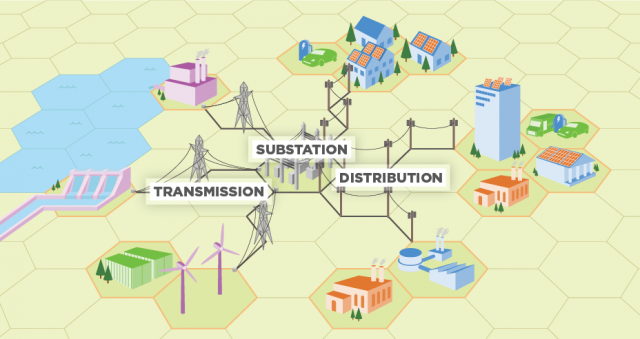Electricity Storage

- About electricity storage
- Electricity storage in the United States
- Environmental impacts of electricity storage
About Electricity Storage
The electric power grid operates based on a delicate balance between supply (generation) and demand (consumer use). One way to help balance fluctuations in electricity supply and demand is to store electricity during periods of relatively high production and low demand, then release it back to the electric power grid during periods of lower production or higher demand. In some cases, storage may provide economic, reliability, and environmental benefits. Depending on the extent to which it is deployed, electricity storage could help the utility grid operate more efficiently, reduce the likelihood of brownouts during peak demand, and allow for more renewable resources to be built and used.
Energy can be stored in a variety of ways, including:
- Pumped hydroelectric. Electricity is used to pump water up to a reservoir. When water is released from the reservoir, it flows down through a turbine to generate electricity.
- Compressed air. Electricity is used to compress air at up to 1,000 pounds per square inch and store it, often in underground caverns. When electricity demand is high, the pressurized air is released to generate electricity through an expansion turbine generator.
- Flywheels. Electricity is used to accelerate a flywheel (a type of rotor) through which the energy is conserved as kinetic rotational energy. When the energy is needed, the spinning force of the flywheel is used to turn a generator. Some flywheels use magnetic bearings, operate in a vacuum to reduce drag, and can attain rotational speeds up to 60,000 revolutions per minute.
- Batteries. Similar to common rechargeable batteries, very large batteries can store electricity until it is needed. These systems can use lithium ion, lead acid, lithium iron or other battery technologies.
- Thermal energy storage. Electricity can be used to produce thermal energy, which can be stored until it is needed. For example, electricity can be used to produce chilled water or ice during times of low demand and later used for cooling during periods of peak electricity consumption.
In addition to these technologies, new technologies are currently under development, such as flow batteries, supercapacitors, and superconducting magnetic energy storage.
Electricity Storage in the United States
According to the U.S. Department of Energy, the United States had more than 25 gigawatts of electrical energy storage capacity as of March 2018. Of that total, 94 percent was in the form of pumped hydroelectric storage, and most of that pumped hydroelectric capacity was installed in the 1970s. The six percent of other storage capacity is in the form of battery, thermal storage, compressed air, and flywheel, as shown in the following graph:

Environmental Impacts of Electricity Storage
Storing electricity can provide indirect environmental benefits. For example, electricity storage can be used to help integrate more renewable energy into the electricity grid. Electricity storage can also help generation facilities operate at optimal levels, and reduce use of less efficient generating units that would otherwise run only at peak times. Further, the added capacity provided by electricity storage can delay or avoid the need to build additional power plants or transmission and distribution infrastructure.
Potential negative impacts of electricity storage will depend on the type and efficiency of storage technology. For example, batteries use raw materials such as lithium and lead, and they can present environmental hazards if they are not disposed of or recycled properly. In addition, some electricity is wasted during the storage process.
